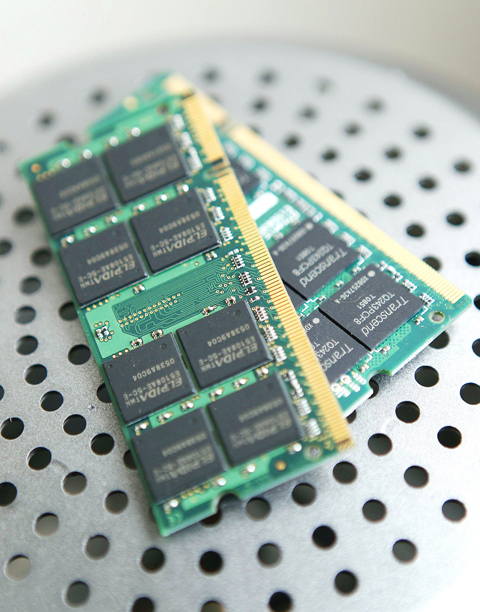Powerchip Semiconductor Corp (力晶半導體), the nation’s No. 2 computer memory chipmaker, submitted a proposal to the Industrial Development Bureau (IDB) yesterday for state funding, following in the footsteps of Taiwan Memory Co (TMC, 台灣創新記憶體公司).
The IDB set a three-month period, starting in July, for local companies to submit proposals about joining the central government’s efforts to rejuvenate the nation’s PC memory, or dynamic random access (DRAM), sector, in exchange for a capital injection from the state.
Powerchip filed its proposal right before yesterday’s deadline on its own, since its technological partner Elpida Memory Inc has formed an alliance with TMC.

PHOTO: NICKY LOH, REUTERS
“We will meet the government’s requirements. We are technologically independent [as the government requested.] We will make chips on technologies we have developed ourselves,” Powerchip spokesman Eric Tang (譚仲民) said by telephone.
Without consolidating any capacities owned by existing memory chipmakers, Powerchip said it planned to allocate part of its DRAM capacity for flash memory chips, which should be seen as a kind of consolidation, Tang said.
The nation’s biggest computer memory chipmaker Nanya Technology Corp (南亞科技) and its joint venture with Micron Technology Inc, Inotera Memories Inc (華亞科技), however, have decided not to seek government funding.
“The DRAM industry is different from what it was a year ago. The best timing for DRAM reformation or consolidation under this scheme has passed. To consolidate partial capacity would not do much to help DRAM restructuring,” the two companies said in a joint statement yesterday.
The Nanya-and-Micron camp was originally seen as a potential contender for the government funding. With full financial backing from fellow Formosa Plastic Group (台塑集團) companies, Nanya has never shown any eagerness for a capital infusion from outside the group.
The IDB said it has not set any timetable for reviewing funding applications. TMC has requested NT$5 billion (US$155 milion) instead of the NT$10 billion it originally planned.
Meanwhile, Nanya and Inotera said they are converting their manufacturing process technology to 50-nanometer technology to lower substantially reduce manufacturing costs.
Mass production of 40-nanometer technology is expected to start in the second half of next year, in collaboration with Micron.

The US dollar was trading at NT$29.7 at 10am today on the Taipei Foreign Exchange, as the New Taiwan dollar gained NT$1.364 from the previous close last week. The NT dollar continued to rise today, after surging 3.07 percent on Friday. After opening at NT$30.91, the NT dollar gained more than NT$1 in just 15 minutes, briefly passing the NT$30 mark. Before the US Department of the Treasury's semi-annual currency report came out, expectations that the NT dollar would keep rising were already building. The NT dollar on Friday closed at NT$31.064, up by NT$0.953 — a 3.07 percent single-day gain. Today,

‘SHORT TERM’: The local currency would likely remain strong in the near term, driven by anticipated US trade pressure, capital inflows and expectations of a US Fed rate cut The US dollar is expected to fall below NT$30 in the near term, as traders anticipate increased pressure from Washington for Taiwan to allow the New Taiwan dollar to appreciate, Cathay United Bank (國泰世華銀行) chief economist Lin Chi-chao (林啟超) said. Following a sharp drop in the greenback against the NT dollar on Friday, Lin told the Central News Agency that the local currency is likely to remain strong in the short term, driven in part by market psychology surrounding anticipated US policy pressure. On Friday, the US dollar fell NT$0.953, or 3.07 percent, closing at NT$31.064 — its lowest level since Jan.

The Financial Supervisory Commission (FSC) yesterday met with some of the nation’s largest insurance companies as a skyrocketing New Taiwan dollar piles pressure on their hundreds of billions of dollars in US bond investments. The commission has asked some life insurance firms, among the biggest Asian holders of US debt, to discuss how the rapidly strengthening NT dollar has impacted their operations, people familiar with the matter said. The meeting took place as the NT dollar jumped as much as 5 percent yesterday, its biggest intraday gain in more than three decades. The local currency surged as exporters rushed to

PRESSURE EXPECTED: The appreciation of the NT dollar reflected expectations that Washington would press Taiwan to boost its currency against the US dollar, dealers said Taiwan’s export-oriented semiconductor and auto part manufacturers are expecting their margins to be affected by large foreign exchange losses as the New Taiwan dollar continued to appreciate sharply against the US dollar yesterday. Among major semiconductor manufacturers, ASE Technology Holding Co (日月光), the world’s largest integrated circuit (IC) packaging and testing services provider, said that whenever the NT dollar rises NT$1 against the greenback, its gross margin is cut by about 1.5 percent. The NT dollar traded as strong as NT$29.59 per US dollar before trimming gains to close NT$0.919, or 2.96 percent, higher at NT$30.145 yesterday in Taipei trading